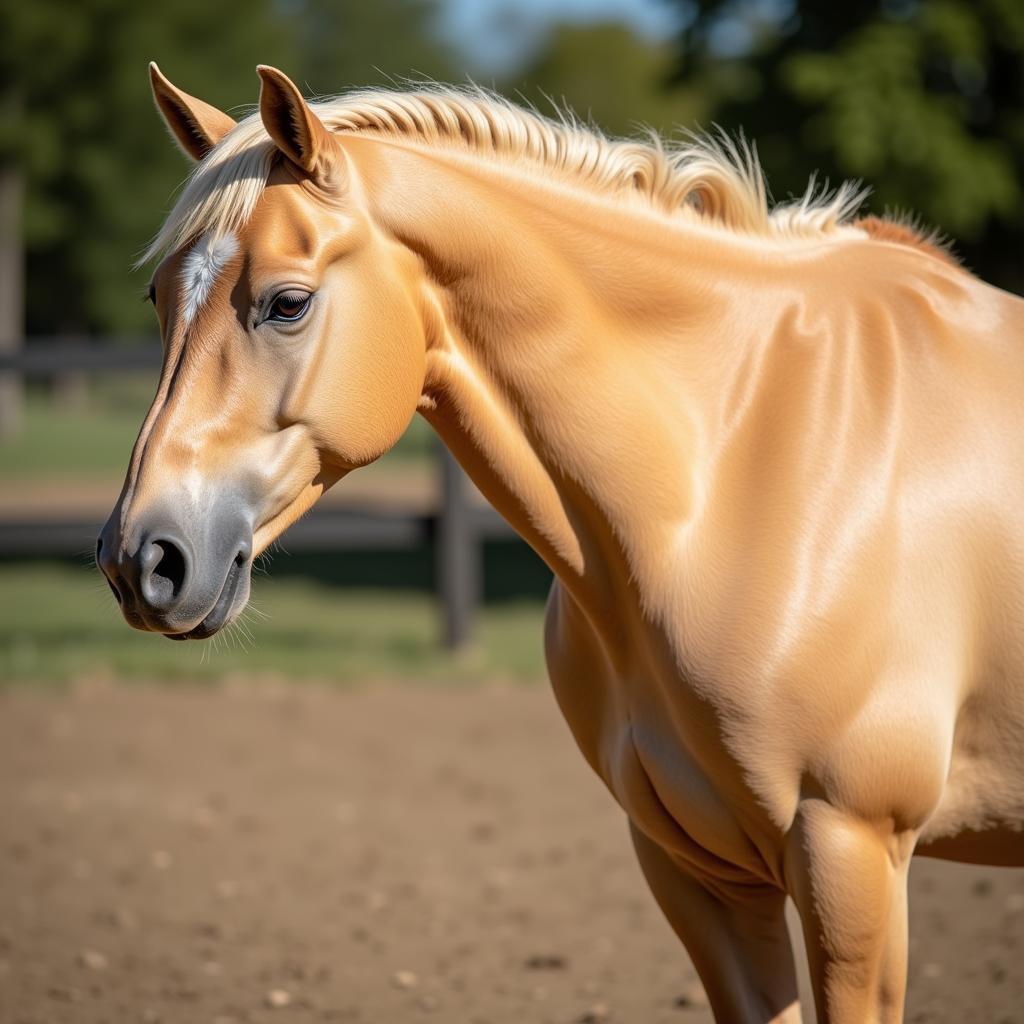Perlino Horse Vs Cremello: These two stunningly pale equine breeds often leave people confused. Their shared creamy coats and striking blue eyes make distinguishing them a challenge. This article dives into the genetics behind these beautiful horses, highlighting the key differences between a perlino and a cremello.
Decoding the Cream Gene
Both perlino and cremello horses owe their unique appearance to the cream gene. This dilution gene acts upon a base coat color, lightening it. The cream gene is an incomplete dominant gene, meaning its effects vary depending on how many copies the horse inherits. One copy produces a single dilute, while two copies result in a double dilute.
Single Dilute vs. Double Dilute: The Key Difference
The core difference between a perlino and a cremello lies in the number of cream gene copies and the underlying base coat color. A perlino is a double dilute of a bay horse, possessing two cream genes. A cremello, on the other hand, is a double dilute of a chestnut horse, also carrying two cream genes.
 Perlino Horse: A Double Dilute Bay
Perlino Horse: A Double Dilute Bay
Understanding the Base Coat Colors: Bay vs. Chestnut
The underlying base coat color is crucial in determining whether a horse is a perlino or a cremello. A bay horse has a brown body with black points (mane, tail, and lower legs), while a chestnut horse has a reddish-brown coat, mane, and tail. The cream gene lightens these base colors, resulting in the distinctive perlino and cremello shades.
Identifying a Perlino
Perlinos exhibit a striking apricot or light orange coat. Their mane and tail are often a slightly darker cream or reddish color. A close inspection might reveal faint remnants of the original bay markings, particularly on the legs. They typically have pink skin and blue or amber eyes.
Identifying a Cremello
Cremellos possess an almost pure white or cream coat, often appearing slightly lighter than perlinos. Their mane and tail are also cream or white. They have pink skin and striking blue eyes.
Beyond the Coat: Other Distinguishing Features
While the coat color is the most obvious difference, other subtle features can help distinguish between the two. Perlinos sometimes retain faint markings from their bay base, whereas cremello’s generally have no visible markings.
Expert Insights: Dr. Amelia Hart, Equine Geneticist
“The cream gene is a fascinating example of how a single gene can dramatically alter a horse’s appearance,” says Dr. Hart. “Understanding its effects on different base coat colors is key to differentiating between these beautiful cream dilutions.”
Perlino vs Cremello: A Quick Comparison
| Feature | Perlino | Cremello |
|---|---|---|
| Base Coat | Bay | Chestnut |
| Cream Genes | Two | Two |
| Coat Color | Apricot/Light Orange | Cream/Near White |
| Mane/Tail | Cream/Reddish | Cream/White |
| Skin | Pink | Pink |
| Eyes | Blue/Amber | Blue |
Conclusion: Appreciating the Subtleties of the Cream Gene
The perlino horse vs cremello debate ultimately boils down to the interaction of the cream gene with different base coat colors. Both breeds are stunning examples of the power of genetics, showcasing the subtle yet significant variations that can arise from a single gene. Understanding these differences allows us to truly appreciate the unique beauty of each horse.
FAQ
- Are perlinos and cremello’s albinos? No, they are not albinos. They have pigment, as evidenced by their blue or amber eyes.
- Are perlinos rarer than cremello’s? Perlinos are generally considered less common than cremello’s.
- Can a perlino and a cremello breed together? Yes, they can breed, and the resulting offspring’s color will depend on the specific genetics of each parent.
- Do perlinos and cremello’s require special care? Their pale coats might make them more susceptible to sunburn, requiring extra care during sunny periods.
- Are perlinos and cremello’s suitable for beginners? Their temperament is similar to other horse breeds, and their suitability for beginners depends on individual training and personality.
- How can I tell if a horse is a perlino or a cremello? This article outlines the key differences, including coat color and underlying base coat, to help you distinguish between the two.
- Do perlinos and cremello’s have any specific health concerns? They don’t have breed-specific health concerns directly related to their color, but like all horses, they can be prone to certain conditions.
Other Questions We Get Asked:
- What are the different types of horse coat colors?
- How does genetics influence horse coat color?
- What are some other rare horse coat colors?
For further information and assistance, contact us at Phone Number: 0772127271, Email: [email protected], or visit us at QGM2+WX2, Vị Trung, Vị Thuỷ, Hậu Giang, Vietnam. Our customer service team is available 24/7.